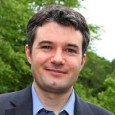All Faculty

Gaurav Arya
Professor in the Thomas Lord Department of Mechanical Engineering and Materials Science

Harold U. Baranger
Professor Emeritus of Physics

Alberto Bartesaghi
Associate Professor of Computer Science

Georgia Marie Beasley
Associate Professor of Surgery

David N. Beratan
R.J. Reynolds Distinguished Professor of Chemistry

Volker Blum
Rooney Family Associate Professor of Mechanical Engineering and Materials Science

Martin A. Brooke
Associate Professor of Electrical and Computer Engineering

April S. Brown
Professor of Electrical and Computer Engineering

Kenneth R Brown
Michael J. Fitzpatrick Distinguished Professor of Engineering

Claude Shreve Burton III
Professor of Dermatology

David Carlson
Yoh Family Associate Professor of Civil and Environmental Engineering

Jun Chen
Professor of Medicine

Jen-Tsan Ashley Chi
Professor in Molecular Genetics and Microbiology

Miaofang Chi
Professor in the Thomas Lord Department of Mechanical Engineering and Materials Science

Ashutosh Chilkoti
Alan L. Kaganov Distinguished Professor of Biomedical Engineering

Emma Jean Chory
Assistant Professor of Biomedical Engineering

Patrick James Codd
Associate Professor of Neurosurgery

Leslie M. Collins
Professor of Electrical and Computer Engineering

Steven A. Cummer
William H. Younger Distinguished Professor of Engineering

Ingrid Daubechies
Professor in the Department of Mathematics

Sandeep S. Dave
Wellcome Clinical Distinguished Professor of Medicine

Olivier Delaire
Associate Professor of the Thomas Lord Department of Mechanical Engineering and Materials Science

Emily R. Derbyshire
Eads Family Professor

Gayathri R. Devi
Professor in Surgery

Mark Wesley Dewhirst
Gustavo S. Montana Distinguished Professor Emeritus of Radiation Oncology

Al-Hafeez Z Dhalla
Assistant Research Professor in the Department of Biomedical Engineering

Richard T. Di Giulio
Research Professor of Environmental Toxicology

Anna Mae Diehl
Florence McAlister Distinguished Professor of Medicine

Jessilyn Dunn
Assistant Professor of Biomedical Engineering

Timothy Dunn
Assistant Professor of Biomedical Engineering

Glenn S. Edwards
Professor Emeritus of Physics

Harold Paul Erickson
James B. Duke Distinguished Professor Emeritus of Cell Biology

Henry Everitt
Adjunct Professor of Physics

Richard B. Fair
Lord-Chandran Distinguished Professor of Engineering

Sina Farsiu
Anderson-Rupp Professor of Biomedical Engineering

Peter Edward Fecci
Professor of Neurosurgery

Greg D. Field
Adjunct Associate Professor of Neurobiology

Gleb Finkelstein
Professor of Physics

Bernard Martin Fischer
Associate Professor in Pediatrics

Martin Fischer
Research Professor in the Department of Chemistry

Katherine J. Franz
James B. Duke Distinguished Professor of Chemistry

Haiyan Gao
Henry W. Newson Distinguished Professor of Physics

Katherine Schuver Garman
Professor of Medicine

Michael E. Gehm
Professor of Electrical and Computer Engineering

Charles Gersbach
John W. Strohbehn Distinguished Professor of Biomedical Engineering

Leanne Gilbertson
Associate Professor of Civil and Environmental Engineering

Geoffrey Steven Ginsburg
Adjunct Professor in the Department of Medicine

Jeffrey Glass
Professor of Electrical and Computer Engineering

Lindsey Glickfeld
Associate Professor of Neurobiology

Yiyang Gong
Adjunct Assistant Professor in the Department of Biomedical Engineering

Joel Alter Greenberg
Associate Research Professor in the Department of Electrical and Computer Engineering

Sonia Grego
Associate Research Professor in the Department of Electrical and Computer Engineering

Russell P. Hall III
J. Lamar Callaway Distinguished Professor of Dermatology, in the School of Medicine

Amanda Hargrove
Research Professor of Chemistry

John Wirthlin Hickey
Assistant Professor of Biomedical Engineering

Brenton D. Hoffman
Associate Professor in the Department of Biomedical Engineering

Roarke Horstmeyer
Assistant Professor of Biomedical Engineering

Nico Hotz
Associate Professor of the Practice in the Thomas Lord Department of Mechanical Engineering and Materials Science

Po-Chun Hsu
Adjunct Assistant Professor in the Thomas Lord Department of Mechanical Engineering and Materials Science

Heileen Hsu-Kim
Professor in the Department of Civil and Environmental Engineering

Jun Huang
William Bevan Distinguished Professor of Mechanical Engineering and Materials Science

Megan Justine Huchko
Hollier Family Associate Professor of Global Health

Brant Allen Inman
Professor of Surgery

Sonke Johnsen
Ida Stephens Owens Distinguished Professor

G. Allan Johnson
Charles E. Putman University Distinguished Professor of Radiology

Nan Marie Jokerst
J. A. Jones Distinguished Professor of Electrical and Computer Engineering

David F. Katz
Nello L. Teer, Jr. Distinguished Professor of Biomedical Engineering, in the Edmund T. Pratt, Jr. School of Engineering

Christopher Ryan Kelsey
Professor of Radiation Oncology

Daniel P. Kiehart
Professor of Biology

Jungsang Kim
Schiciano Family Distinguished Professor of Electrical and Computer Engineering

David Guy Kirsch
Adjunct Professor in the Department of Radiation Oncology

Bruce Klitzman
Associate Professor Emeritus in Surgery

George Dimitri Konidaris
Adjunct Assistant Professor of Computer Science

Jeffrey L. Krolik
Professor of Electrical and Computer Engineering

Anthony Nanlin Kuo
Professor of Ophthalmology

Shivanand Lad
Professor of Neurosurgery

Daniel Todd Laskowitz
Professor of Neurology

Walter T Lee
Professor of Head and Neck Surgery & Communication Sciences

Hai "Helen" Li
Marie Foote Reel E'46 Distinguished Professor of Electrical and Computer Engineering

Natalia Litchinitser
Professor of Electrical and Computer Engineering

Jie Liu
George Barth Geller Distinguished Professor of Chemistry

Huanqian Loh
Assistant Professor of Electrical and Computer Engineering

Jianfeng Lu
James B. Duke Distinguished Professor of Mathematics

Paolo F Maccarini
Associate Research Professor in the Department of Electrical and Computer Engineering

Robert A. Malkin
Professor of the Practice Emeritus in the Department of Biomedical Engineering

Hisham Z. Massoud
Professor of Electrical and Computer Engineering

Ryan McNabb
Assistant Professor of Ophthalmology

Maiken Mikkelsen
Professor in the Department of Electrical and Computer Engineering

David Mitzi
Simon Family Distinguished Professor

Christopher R Monroe
Gilhuly Family Presidential Distinguished Professor

Samira Musah
Assistant Professor in the Department of Biomedical Engineering

Barry S. Myers
Professor of Biomedical Engineering

Travis L Nicholson
Assistant Professor of Physics

Crystal Noel
Assistant Professor of Electrical and Computer Engineering

Willie John Padilla
Dr. Paul Wang Distinguished Professor

Miroslav Pajic
Professor in the Department of Electrical and Computer Engineering

Gregory M. Palmer
Professor of Radiation Oncology

Richard A. Palmer
Professor Emeritus of Chemistry

Christine K. Payne
Professor in the Thomas Lord Department of Mechanical Engineering and Materials Science

Zhen-Ming Pei
Associate Professor of Biology

Niko P. Pitsianis
Adjunct Professor of Computer Science

James Michael Provenzale
Professor of Radiology

Nimmi Ramanujam
Robert W. Carr, Jr., Distinguished Professor of Biomedical Engineering

Amanda Randles
Associate Professor of Biomedical Engineering

William M. Reichert
Professor Emeritus of Biomedical Engineering

John H. Reif
A. Hollis Edens Distinguished Professor of Computer Science

Weston Ross
Assistant Professor in Neurosurgery

Michael Rubinstein
Aleksandar S. Vesic Distinguished Professor

Ehsan Samei
Reed and Martha Rice Distinguished Professor of Radiology

Guillermo Sapiro
James B. Duke Distinguished Professor Emeritus of Electrical and Computer Engineering

Christoph F. Schmidt
Hertha Sponer Distinguished Professor of Physics

Daniel M. Scolnic
Associate Professor of Physics

William Seaman
Professor of Art, Art History and Visual Studies

Tatiana Segura
Professor of Biomedical Engineering

Allan B. Shang
Adjunct Assistant Professor of Biomedical Engineering

Ryan Shaw
Associate Professor in the School of Nursing

Xiling Shen
Adjunct Professor in the Department of Pathology

David R. Smith
James B. Duke Distinguished Professor of Electrical and Computer Engineering

Marc A. Sommer
Professor of Biomedical Engineering

Adrienne Stiff-Roberts
Professor of Electrical and Computer Engineering

Amanda Kristine Suggs
Assistant Professor of Dermatology

Tai-ping Sun
John Carlisle Kilgo Distinguished Professor of Biology

Xiaobai Sun
Professor of Computer Science

Steve M Taylor
Professor of Medicine

Michael J. Therien
William R. Kenan, Jr. Distinguished Professor of Chemistry

Nathan Maclyn Thielman
Professor of Medicine

Eric John Toone
Professor Emeritus of Chemistry

Cynthia Ann Toth
Joseph A.C. Wadsworth Distinguished Professor of Ophthalmology

Michael A. Troxel
Associate Professor of Physics

George A. Truskey
R. Eugene and Susie E. Goodson Distinguished Professor of Biomedical Engineering

Ganesan Vaidyanathan
Professor Emeritus in Radiology

Hans J. Van Miegroet
Professor of Art and Art History

Shyni Varghese
Laszlo Ormandy Distinguished Professor of Orthopaedic Surgery

Stephanos Venakides
Professor of Mathematics

Tuan Vo-Dinh
R. Eugene and Susie E. Goodson Distinguished Professor of Biomedical Engineering

Christopher Walter
Professor of Physics

Qiu Wang
Professor of Chemistry

S. Warren
James B. Duke Distinguished Professor of Chemistry

Adam P. Wax
Professor of Biomedical Engineering

Kevin D. Welsher
Robert R. & Katherine B. Penn Associate Professor

Heather Elizabeth Whitson
Duke School of Medicine Distinguished Professor in Neuroscience

Benjamin J. Wiley
Professor of Chemistry

Christopher Wildrick Woods
Wolfgang Joklik Distinguished Professor of Global Health

Ying Wu
Professor of Physics

Huanghe Yang
Associate Professor of Biochemistry

Weitao Yang
Philip Handler Distinguished Professor of Chemistry

Junjie Yao
Jeffrey N. Vinik Associate Professor of Biomedical Engineering

Terry Takatoshi Yoshizumi
Professor of Radiology

Lingchong You
James L. Meriam Distinguished Professor of Biomedical Engineering

Fan Yuan
Professor of Biomedical Engineering

Aimee Kirsch Zaas
Professor of Medicine

Michael Rod Zalutsky
Jonathan Spicehandler, M.D. Distinguished Professor of Neuro Oncology, in the School of Medicine

Pei Zhong
Professor in the Thomas Lord Department of Mechanical Engineering and Materials Science
